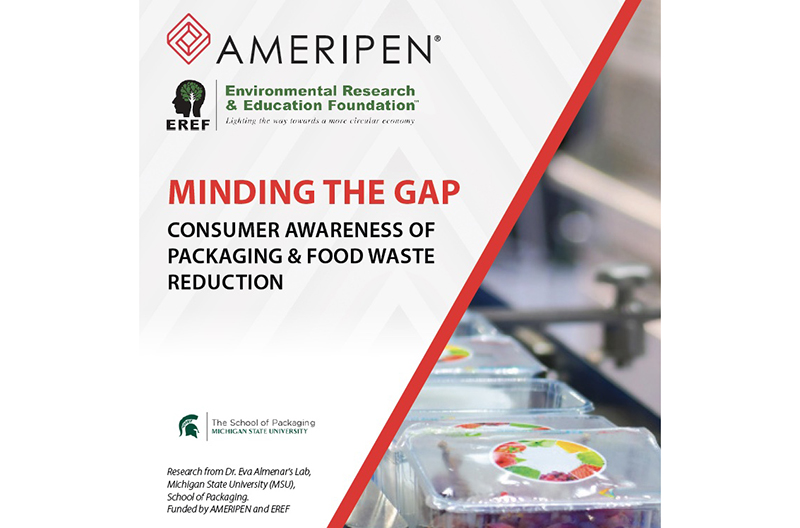New research from Michigan State University’s School of Packaging sheds light on how consumers’ understanding of packaging technology may help combat the growing problem of food waste.
Minding the Gap: Consumer Awareness of Packaging & Food Waste Reduction, a white paper summarizing MSU’s research, offers key insights into types of wasted food and package design strategies. In addition, it details opportunities to better educate consumers about the features and value of packaging to help them reduce food waste.
The study was sponsored by AMERIPEN, the American Institute for Packaging and the Environment, and the Environmental Research and Education Foundation.
The report, which analyzed data from a questionnaire distributed nationwide to more than 1,000 respondents of varying demographics, found that fruits and vegetables, prepared foods and dairy are the most frequently wasted food categories in American households.
Packaging, or a lack thereof, is a strong influencing factor on food freshness and waste in these categories.
More than half of fresh whole fruits and vegetables – the most wasted food group cited by participants – were not packaged and frequently spoiled before consumption.
Based on those findings, the researchers assert that some fresh food products, particularly produce, could benefit from packaging to extend shelf life and thereby reduce food waste.
Researchers also found that consumers prefer packaging that more clearly states the shelf life of food products. Also, active and intelligent packaging technologies, which help consumers identify freshness, could further reduce household food waste.
Consumer insight
When researchers polled consumers about their packaging preferences for in-home food waste reduction, respondents prioritized food freshness, package resilience and product dating as most important.
Researchers also found when study participants were better informed about specific packaging technologies, they often stated a willingness to buy – and in some cases a preference for – food contained in packaging that helps reduce food waste. Some would be willing to spend more money on such products.
While this data gives industry leaders an incentive to develop more sophisticated food protection technologies, the study also noted that many U.S. consumers don’t understand how different types of packaging can preserve food and stretch household budgets.
“While participants showed some understanding of how packaging protects against physical damage, they were not adept at identifying the best structural packaging designs for keeping different types of food fresh,” said Eva Almenar, lead researcher.
“Specifically, the impact of only three out of 15 structural packaging designs on maintaining food freshness was known by more than 50 percent of respondents.”
Added Korey Fennell, a student who performed the study, “Only 30 percent or less of respondents understood advanced packaging technologies for freshness, including intelligent packaging, modified atmosphere packaging, active packaging, aseptic packaging and retort packaging.”
How industry can help
The study concludes with several recommendations for industry. In terms of design, CPG brands can develop packaging that extends shelf life upon opening. They should also continue to come up with designs that indicate the shelf life of the food product.
“Extending shelf life is just one of many strategies food packaging designers must consider, and this study reinforces that. While we have made great strides with innovations to reduce food waste, they are underutilized if consumers don’t recognize their value,” said Dan Felton, executive director of AMERIPEN.
“There is great opportunity here, and industry and government can together take a proactive stance in addressing this critical issue.”
When thinking about consumer education, the researchers suggest launching awareness and education initiatives that teach people about the various packaging technologies, formats and features that keep food fresh.
“While MSU’s study is an important first step, there is more work to be done,” said Bryan Staley, president and CEO of EREF.
“Specifically, the report suggests additional study into how consumers use advanced packaging technologies – a worthy cause in the name of innovating for waste reduction and the circular economy.”
Read more packaging news from The Shelby Report.

